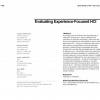33 search results - page 1 / 7 » Using a low-cost electroencephalograph for task classificati... |
UIST
2006
ACM
13 years 10 months ago
2006
ACM
Modern brain sensing technologies provide a variety of methods for detecting specific forms of brain activity. In this paper, we present an initial step in exploring how these tec...
CHI
2008
ACM
14 years 5 months ago
2008
ACM
A reliable and unobtrusive measurement of working memory load could be used to evaluate the efficacy of interfaces and to provide real-time user-state information to adaptive syst...
HCI
2009
13 years 2 months ago
2009
The posterior parietal cortex (PPC) plays an important role in motor planning and execution. Here, we investigated whether noninvasive electroencephalographic (EEG) signals recorde...
CHI
2007
ACM
13 years 8 months ago
2007
ACM
A prototype of computing technology--as a means to evaluate and communicate a good idea--is often an essential step towards useful, shipping products and towards a deeper understa...
CHI
2007
ACM
14 years 5 months ago
2007
ACM
A growing trend in the field is the development of experience-focused HCI, which emphasizes the experience of using the technology, rather than the focus on the task that is chara...


